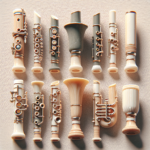When discussing clarinets, much attention is given to reeds, mouthpieces, and even the wood of the body. However, there's a hidden hero in shaping the instrument's performance: the clarinet bell ring materials. It may seem like a tiny detail, but this component plays a significant role in affecting the sound, resonance, and overall experience of playing.
First, what are clarinet bell rings? If you look closely at the flared end of your clarinet—the bell—you'll notice a metallic or sometimes composite ring fixed around the edge. This ring isn't just for show! It reinforces the bell's structure and, more importantly, influences sound projection and tonal warmth.
Some clarinetists say they can “hear” the difference between various bell ring materials, while others think it's a subtle effect. No matter what you believe, knowing about this small but important part can help you make better choices as a player or buyer.
The Common Contenders in Bell Rings
The most common materials used for clarinet bell rings are metal, plastic, and wood. However, new advances in instrument-making have brought in a variety of new combinations; even carbon fiber and other composites are now being used.
| Material | Characteristics | Best For |
|---|---|---|
| Metal (Brass, Nickel Silver) | Durable, creates sharp and defined sound | Classical settings, professional use |
| Plastic | Lightweight, affordable, less impact on tone | Beginners, school instruments |
| Wood | Warm tone, aesthetically pleasing | High-end instruments, professional use |
- Metal Bell Rings: Brass and nickel silver are often used for their durability and distinctive effect on tone. These metals help create a sharper, more defined sound, which makes them ideal for clarinets designed for classical settings. Some musicians say they can feel the added “brightness” in their notes with metal bell rings installed.
- Plastic Bell Rings: More common on beginner models, plastic rings are lightweight and affordable. They contribute less to tone shaping than their metal counterparts, but they're popular in school and starter instruments for their practicality.
- Wooden Bell Rings: For those lucky enough to own high-end instruments, wooden bell rings are not uncommon. These rings mirror the warmth of the wood body, contributing to a fuller sound. Some advanced Martin Freres Clarinets feature elegant wood-matched rings that seamlessly blend aesthetics without sacrificing quality.
Impact Beyond the Sound
The benefits of bell ring materials aren't limited to tonal quality. Structural reinforcement is another key factor. Clarinets are delicate instruments, and the bell is susceptible to cracks or chips due to its exposed position. A sturdy ring, regardless of material, protects the integrity of this vulnerable section.
Choosing the right material often comes down to how you balance your priorities: sound, durability, and affordability. For instance, while professionals might prefer metal or wood for their tonal advantages, that doesn't mean plastic options should be ignored, especially for new learners or marching band players often exposed to changing weather conditions.
Myth or Masterstroke? Do Bell Rings Really Make a Difference?
Let's talk about the big question: does the material of a bell ring really matter? While some traditionalists say it's all in the musician's mind, others swear they've noticed clear changes in projection and resonance just by changing bell rings. It's interesting to note that clarinet brands like Martin Freres put a lot of effort into getting the right tonal balance by testing these small details in their designs. So, even if it's not the most talked-about feature, it's definitely not unimportant.
Experimenting to Find Your Fit
If you can, try different options! The best way to understand the difference between materials is to use a clarinet with changeable bells. Some setups allow you to switch out bells with different materials, letting you compare them during practice. You don't need to do this all the time, but these tests can show you what you like best.
Future Trends and Bell Innovation
Instrument makers are always trying new things, and bell ring materials are no exception. From mixing wood with new metal alloys to rings made specifically for different performance spaces, the clarinet world is always changing. Well-known brands like Martin Freres often lead the way in both looks and effectiveness.
Whether you're just starting out, an experienced player, or someone who loves every part of how instruments are made, bell ring materials are worth paying attention to. Even a small change can sometimes bring unexpected richness or character to your sound.







